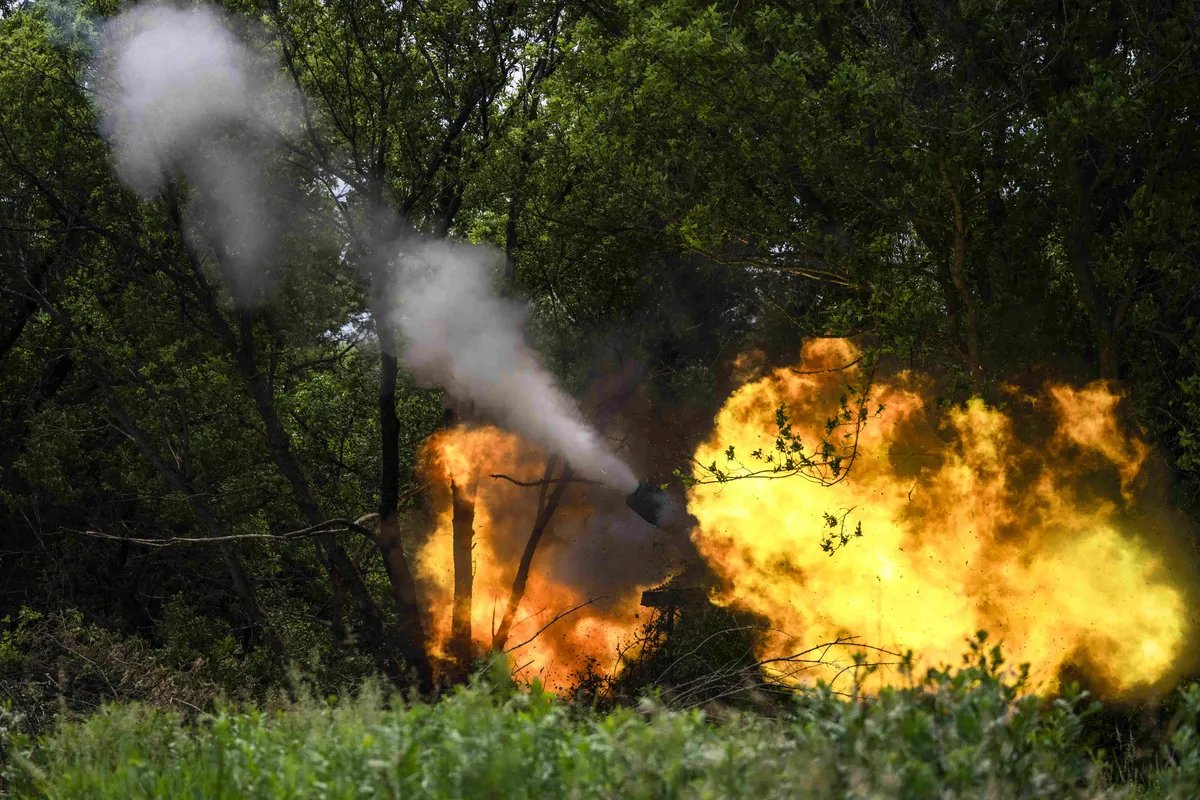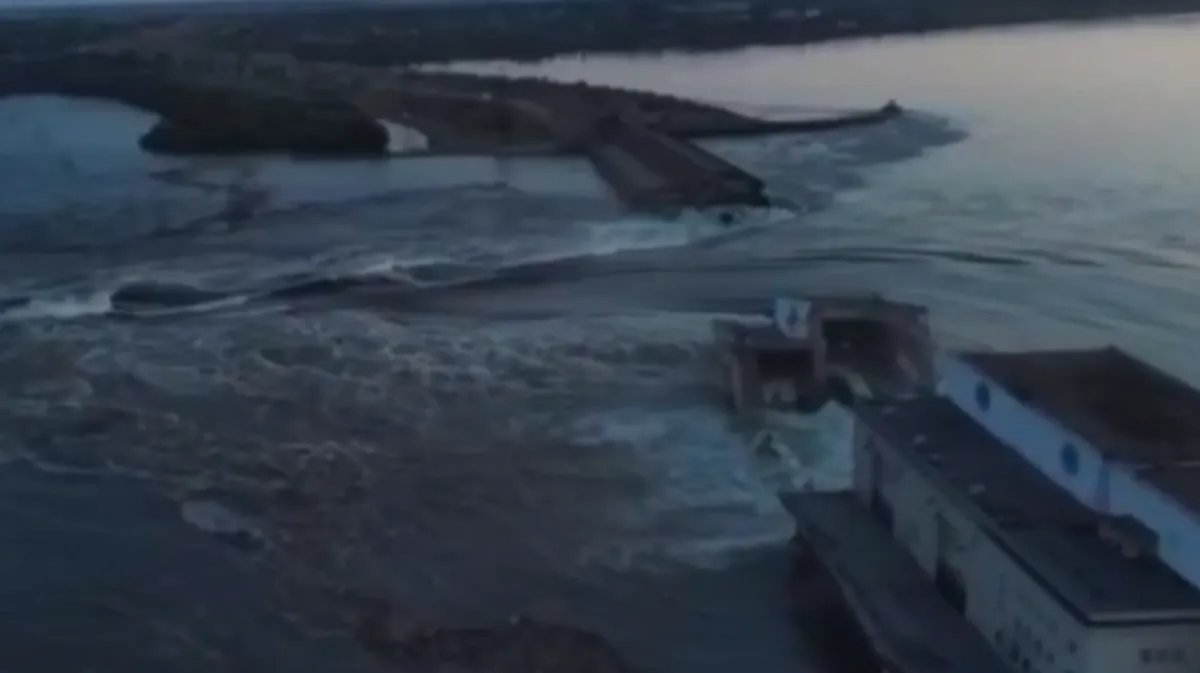The Kakhovka Hydroelectric Power Plant (HPP) dam was reportedly blown up on 6 June, which will likely flood the Russian army positions in the Kherson region. Reports on the situation in the Belgorod region are conflicting. Since June, the Russian Volunteer Corps and the Freedom of Russia Legion have been making incursions there. Novaya-Europe is investigating whether this marks the start of a long-awaited counter-offensive.
Fantastic losses
According to the Russian Defence Ministry, the Ukrainian side already suffered a complete defeat during their attempt at a counteroffensive. The Russian military reported that over 1,500 Ukrainian personnel, 28 tanks (including 8 German Leopards), three AMX-10 wheeled tanks manufactured by France, and 109 armoured combat vehicles were lost in the area of southern Donetsk. The Russian military has not presented any photos or videos of destroyed enemy personnel and equipment. Based on this, even those who support Moscow are sceptical of these claims (due to the lack of evidence). After all, the fighting should have been highly intense for so many soldiers to have died so quickly.
On June 5, Ukrainian Deputy Defence Minister Hanna Malyar described her vision of the events as follows:
“We are beginning an offensive on certain fronts, with the Bakhmut direction remaining the epicentre of hostilities.
We are advancing on a broad front there successfully. We’re taking the dominant heights. To the south, the enemy is on the defensive. There’s local fighting going on.”
“We have to rely on available information from both sides and reports from ‘war correspondents’, and all this is hard to verify in the fog of war,” Israeli military expert David Sharp tells Novaya-Europe. “From the confirmed data, we can conclude that the fighting so far has been of a localised nature. We haven’t seen the engagement of major forces. For over two months, Ukraine hasn’t attacked anywhere except Bakhmut. In fact, until now, the clashes have happened only in a couple areas of the frontline. These were attacks in small numbers, with no attempt to break through the defences to greater depths. Within such a framework, the Ukrainians have made some progress and advanced. However, in one of the directions, they were pushed back and lost several equipment units.”
David Sharp said a large-scale offensive could begin in the coming days or even hours. It would be a series of strikes, including decoys, designed to mislead the enemy, probe the defences and find weaknesses.
Day and night
The Israeli expert argues that the Russian Volunteer Corps and the Freedom of Russia Legion raids in the Belgorod region are also part of a larger plan designed to draw out the Russian forces. The media ruckus that followed the incursions should force the Kremlin to respond to a new kind of threat and shift reserves there. David Sharp recalls strikes against the Russian forces’ rear lines in Mariupol, Berdyansk and other occupied towns. However, he claims that in the run-up to the most active phase of the counter-offensive, high-intensity artillery and rocket fire will be directed at Russian troops, which is not happening now.
It must begin just before the attacks start. Otherwise, Moscow would have time to bring fresh forces to the location of the units targeted in the attacks and make up for the losses.
Some experts suggest that Kyiv is waiting for Western aviation to arrive to launch a counter-offensive. However, David Sharp disagrees. “Waiting for aviation practically means not advancing in the foreseeable future,” claims the Israeli expert. “The planes may arrive in autumn or even winter. The allies have already handed over all major equipment promised under the lend-lease.
Moreover, these tanks and infantry fighting vehicles are usually equipped with night vision and thermal imaging cameras, enabling their use at night. Most Russian combat vehicles cannot boast these features. So night can be an advantage for Ukraine, and even the daylight length will not be a decisive factor for a successful offensive. For example, Oleksandr Khodakovsky (commander of the so-called “people’s militia” of the Donetsk “people’s republic”) reported hostilities at night.” According to David Sharp, the delay in the long-awaited counter-attack can only be due to additional training.
Hot phase
“We are witnessing the beginning of the hot phase of the counter-offensive,” Roman Svitan, a reserve colonel in the Armed Forces of Ukraine, told Novaya-Europe. “Battalions and battalion-strengthened tank companies have already begun to move in, conducting combat reconnaissance deep into the first Russian defence line. Crews will follow them within about a week. Then the corps will join them. A massive artillery and missile strike will precede the most extensive attacks. Events in the Belgorod region are also directly linked to this forthcoming phase — the attacks successfully divert the attention and some units from the front. The available police and Russia’s National Guard forces were insufficient to resist the incoming forces of the Russian Volunteer Corps and the Freedom of Russia Legion. The mere sight of a real tank horrifies the available forces. And sending conscripts there means sending them to slaughter. Moscow will have to send army military units to the hotspot, exposing certain parts of the front. That is where the Ukrainian Armed Forces will strike.”
In Roman Svitan’s opinion, the Russians have recently doubled or tripled the concentration of their forces in Mariupol, Berdyansk and Melitopol, thus causing the Ukrainian shelling of these cities. It is also part of preparations for a major counter-offensive.
Roman Svitan is confident that despite the deeply echeloned defence system erected by the Russian side, the Ukrainian army will be able to overcome it with the help of engineering troops and special equipment. For example, in some places, the first line with permanent firing points, concrete obstacles, and rows of trenches has already been broken through.
“Ukrainian sappers are clearing their own and Russian minefields,” Roman Svitan says. “Special units are busy moving the equipment deep into enemy positions. At some sites, they have already caused the Russians on the frontline to flee. For the most part, experienced and well-trained reserves are engaged in the fighting instead of retreating units. But their number is limited.”
A duel of wills
“We are seeing a clear increase in the intensity of fighting in different parts of the front,” Sergey Migdal, a former Israeli police and intelligence officer, told Novaya-Europe. “We also see more frequent strikes on logistics infrastructure, fuel depots and other facilities of military importance. I can call it the offensive of the twenty-first century. The Ukrainians simply cannot fight the way WWI and WWII were fought, with huge masses of men and equipment and massive artillery strikes. Today, intelligence assets on both sides allow them to monitor the movement of large formations and forces. Concentrating large formations in one place close to the front is virtually impossible without exposing them to artillery fire. In addition, Ukraine has comparatively little aviation required to suppress enemy MLRS and artillery. So I expect numerous attacks in various places soon. These will be attempts to upset the balance of the Russians’ defence. Once they identify the vulnerable parts, the main fresh units from the trained brigades will go there. They will develop the initiative they have received. And long-range Ukrainian multiple rocket launchers and artillery will hit Russian reserves brought in from other parts of the line of contact. In these weakened areas, there will also be attacks by Ukrainian mobile units, causing a ‘domino effect’: the collapse of the entire front. Such a strategy could be very successful.”

Ukrainian artillery near Bakhmut. Photo: Muhammed Enes Yildirim / Anadolu Agency / Getty Images
Sergey Migdal believes such plans could have been repeatedly discussed and elaborated during drills with Western allies. However, according to the expert, Russia has now accumulated enough forces to deter even a large-scale Ukrainian offensive with a competent approach. Everything will depend on the determination and courage of the Russian soldiers defending their positions.
“Achieving a three- to four-fold advantage in manpower and equipment will be difficult for Ukraine,” Sergey Migdal concludes. “So we will see first and foremost a clash of wills, morale, motivations of the sides and the willingness to sacrifice their lives for victory. If the Russians falter and flee, all their three lines of defence will remain nothing but an engineering feat.”
Join us in rebuilding Novaya Gazeta Europe
The Russian government has banned independent media. We were forced to leave our country in order to keep doing our job, telling our readers about what is going on Russia, Ukraine and Europe.
We will continue fighting against warfare and dictatorship. We believe that freedom of speech is the most efficient antidote against tyranny. Support us financially to help us fight for peace and freedom.
By clicking the Support button, you agree to the processing of your personal data.
To cancel a regular donation, please write to [email protected]

